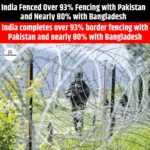17th Anniversary of Mumbai 26/11 Attacks
|
General Studies Paper II: India and its Neighbourhood, Internal Security Through Communication Networks |
Why in News?
The National Security Guard (NSG) is set to organise a commemorative event at Mumbai’s Gateway of India on 26 November 2025, marking the 17th anniversary of the 26/11 Mumbai attacks.
Historical Background of the 26/11 Mumbai Attacks
The 26/11 Mumbai attacks were a series of coordinated terrorist strikes carried out from 26 to 29 November 2008 by ten militants of Pakistan-based militant group Lashkar-e-Taiba. They targeted major public locations in Mumbai.
- Preparation: The 26/11 Mumbai attacks were the result of a long cycle of preparation by the terror group Lashkar-e-Taiba (LeT). The group used safe locations in Pakistan to train ten young men in weapons handling, marine movement, and urban warfare. The training process happened in 2007 and 2008. They were trained at several locations in Pakistan, primarily in Muridke, Muzaffarabad, and in the province of Sindh, Karachi and Thatta.
- Infiltration: The attackers moved from the port city of Karachi on 23 November 2008. They traveled on a larger vessel until they reached a point close to Indian waters. They hijacked an Indian fishing trawler named Kuber. They killed the crew and moved closer to the coast on 26 November 2008. They landed at Badhwar Park in Mumbai around 8 pm and split into smaller teams after reaching the shore.
- Major Attacks: The attacks began with the first rounds of gunfire around 9.40 pm. The first rounds of gunfire hit the Chhatrapati Shivaji Terminus (CST), where two attackers opened fire on passengers on platforms and waiting areas.
- The next major attack happened at the Leopold Café. Two attackers fired at diners and staff for a few minutes. The attackers then moved toward other locations.
-
-
- They also attacked the Taj Mahal Palace Hotel, the Oberoi-Trident, and Nariman House. The attackers entered the Taj Hotel around 9.50 pm and the siege at the Taj lasted nearly 60 hours.
- Nariman House, also known as the Chabad House, saw a hostage situation that involved an international Jewish outreach centre. The attackers held residents captive for two days.
-
- Casualties: The attacks caused severe loss of life. A total of 166 people died. More than 300 individuals suffered injuries. The victims included Indian citizens, security personnel, and foreign nationals from several countries.
- The deaths also included members of the Mumbai Police such as ATS Chief Hemant Karkare, Additional Commissioner Ashok Kamte, and Encounter Specialist Vijay Salaskar.
- Neutralisation: The operations ended on 29 November 2008 when the last attacker at the Taj Hotel was neutralised. The National Security Guard (NSG) played a key role in clearing each site.
- The security forces captured one attacker alive at Girgaum Chowpatty named Ajmal Kasab. His statements confirmed the involvement of the LeT leadership. The court found him guilty under several charges including waging war against the nation. He was executed in 2012 after all legal procedures ended.
Indian Security Vulnerabilities Exposed by the 26/11 Attacks
- Weak Coastal Surveillance: The 26/11 attacks exposed a serious weakness in India’s coastal security system. The attackers travelled by sea from Karachi and entered Indian waters without detection. The agencies did not track the fishing trawler Kuber, which the attackers hijacked. This incident showed that India needed better radar coverage, stronger patrolling, and trained coastal police units.
-
- Limited Intelligence Coordination: The incident exposed gaps in intelligence coordination in 2008. Different agencies had small pieces of warning information about a possible sea route attack. The agencies did not share these warnings in a unified manner. The state police did not receive timely updates. The intelligence system failed to convert warnings into strong preventive action.
- Lack of Quick-Response: The events exposed gaps in India’s quick-response capacity in 2008. The National Security Guard (NSG) was based in Delhi at that time. The force reached Mumbai only after several hours because it required aircraft to transport teams. The delay allowed the terrorists to hold positions inside hotels and other locations. The city lacked a specialised urban counterterror unit.
- Absence of Integrated Management: The event exposed gaps in real-time information flow across agencies. There was no single command centre to manage multi-site attacks. The terrorists used satellite phones to stay in contact with their handlers. The police did not have the tools to intercept these signals quickly. The lack of a unified command system delayed decision-making.
What Key Reforms Taken by India against Counterterrorism System?
- UAPA Amendments: India strengthened its counterterrorism system through major changes in the Unlawful Activities Prevention Act (UAPA). The government amended the law in 2004, 2008, 2012, and 2019 to address new threats. The law allows the government to declare an organisation as a terrorist entity after reviewing evidence. The 2019 amendment gave the government the power to designate individuals as terrorists. It gives agencies the authority to act against networks that operate across states.
- National Investigation Agency (NIA): India created the National Investigation Agency (NIA) in 2008 after the Mumbai attacks. The agency started operating in 2009. Its goal was to investigate terror cases across states with a central mandate. India amended the NIA Act in 2019 to increase the powers of the agency. The amendment allowed the NIA to investigate crimes related to human trafficking, illegal arms trade, cyber terrorism, and attacks on Indian nationals abroad.
- International Cooperation: India expanded its global cooperation after the 2008 attacks. India signed agreements with the United States, the United Kingdom, Israel, France, and other partners to improve intelligence exchange. India works with the Financial Action Task Force (FATF) to pressure states that support terror networks. India also participates in the UN Security Council Counter Terrorism Committee. India also conducts joint military exercises to improve counterterror skills.
- National Security Institutions: India developed new institutions and created the National Intelligence Grid (NATGRID) in 2009. The system links databases from different government departments to access information about travel records, bank accounts, and communication patterns. India strengthened the Multi Agency Centre (MAC) under the Intelligence Bureau. The centre shares daily intelligence with state units. India also established regional hubs for the National Security Guard (NSG) in Mumbai, Kolkata, Chennai, and Hyderabad after 2009. This helps India respond faster to urban terror events.
- Maritime & Border Security: India upgraded the coastal surveillance network through radar stations and automatic identification systems. India commissioned the Information Management and Analysis Centre in Gurgaon. India strengthened border fencing and surveillance systems along the Line of Control after 2008. India also expanded the capacity of the Border Security Force and other border units.
India–Pakistan Relations After 26/11
- The 26/11 attacks created a deep crisis in India–Pakistan relations. India presented evidence of the attack and demanded strong action against the handlers from Pakistan. The government suspended the peace talks that had started in 2004. India stated that dialogue could not continue while terrorism remained active across the border.
- Pakistan admitted that the attackers came from its territory. Pakistan filed cases against a few suspects in 2009. The investigations moved slowly. India argued that Pakistan did not act against the main leaders of the group. This disagreement created friction in the diplomatic process.
- India and Pakistan attempted several rounds of dialogue after 2008. Leaders met at events in 2010, 2011, 2014, and 2015. The talks aimed to restart the peace process that had slowed after the attacks but new incidents stopped the process every time.
- The 2016 Pathankot attack and the 2016 Uri attack again brought relations to a low point. India stated that Pakistan must dismantle terror networks before talks could move forward. Confidence-building measures stalled and cultural exchanges and trade discussions reduced. India vowed to “isolate Pakistan in the world” and conducted “surgical strikes” across the Line of Control (LoC) on alleged terror launch pads.
- India presented its case at the United Nations, the Financial Action Task Force (FATF), and other global platforms. India asked countries to recognise the role of Pakistan-based groups in cross-border attacks. FATF placed Pakistan on the grey list in 2018 because of concerns about terror financing.
- In February 2019, a suicide bombing by a Jaish-e-Mohammed militant struck a CRPF convoy in Pulwama, killing 40 personnel and injuring 35 more. Later the Indian Air Force conducted Balakot airstrikes on JeM training camps in Pakistan, marking a rare cross-border operation.
- On 22 April 2025, terrorists opened fire on tourists in the Baisaran meadow near Pahalgam, killing 26 people, including two foreign nationals. Immediately, the government also stepped up diplomatic pressure and launched Operation Sindoor, targeting suspected terrorist infrastructure.
- India and Pakistan today maintain a tense and limited relationship. Diplomatic dialogue remains suspended, and both sides engage only in essential communication. The February 2021 ceasefire reaffirmation along the Line of Control has reduced large-scale firing, but trust has not improved. India continues to prioritise action against cross-border terrorism, while Pakistan links engagement to the Kashmir issue. The relationship remains stable at the surface but strained at the core.
|
Also Read: Tahawwur Hussain Rana Extradition Case |










